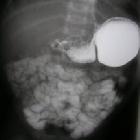Magenausgangsstenose bei Kindern
 ähnliche Suchen
ähnliche SuchenMagenausgangsstenose bei Kindern
Magenausgangsstenose Radiopaedia • CC-by-nc-sa 3.0 • de
Gastric outlet obstruction is a syndrome resulting from mechanical obstruction of stomach emptying.
Pathology
Etiology
Gastric outlet obstruction can be due to malignant or benign causes.
Malignant
- adenocarcinoma (second most common )
- GIST
- lymphoma (less common than other malignancies as it is a "soft" tumor )
- metastases
Benign
- duodenal or gastric peptic ulcers (most common )
- pancreatic pseudocysts
- gastric varices
- granulomatous disease, e.g. Crohn disease, sarcoidosis, tuberculosis
- gallstones (Bouveret syndrome): rare
- strictures, e.g. from caustic substance ingestion
- gastric antral web
- gastric volvulus
- Rapunzel syndrome
See also
Siehe auch:
und weiter:
 Assoziationen und Differentialdiagnosen zu Magenausgangsstenose bei Kindern:
Assoziationen und Differentialdiagnosen zu Magenausgangsstenose bei Kindern:





